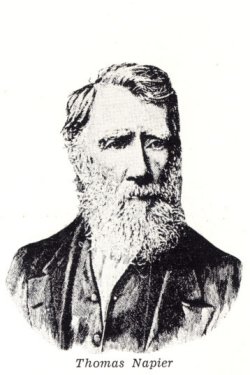|
Strathmore Community History |
| ► | Home Page |
| ► | History
Home Page |
Napier Family
Thomas Napier
Thomas Napier was born in 1802 in Scotland. He was the son of James Napier, a weaver from Montrose and Margaret Suttor. He had a number of jobs in Scotland, working as a clerk and training as a carpenter. He also received a couple of years of training as an artist.
In 1832 he left Britain with his business partner John Brown (who was later to build "Como" house# in South Yarra). They arrived in Hobart Town# in the same year and commenced work on the construction of several buildings.
In 1836 he married Jessie Paterson, who had arrived in
Hobart Town earlier that year also from Scotland. Jessie
bore a total of 10 children however 6 dies in infancy and
further 2 died before they were twenty, leaving only 2
children surviving into adulthood.
Mr. Napier was dissatisfied with conditions in Hobart and Van Diemen's land and in 1837 sailed for the settlement at Melbourne. This was only two years after the first permanent settlement on the Yarra River by parties of settlers organised by John Batman# and John Pascoe Fawkner#. (Click Here# to read more about the early history of Melbourne.)
When Napier arrived in Melbourne no land had yet been made available for purchase and most of the structures in the area were still temporary, constructed using "wattle and daub". In the first land sale in Melbourne he purchased a half acre allotment in Collins Street for 20 pounds. In a subsequent sale a few months later he purchased another quarter acre allotment (also for 20 pounds). He built a "wattle and daub" cottage on one of the sites and continued with his building business.
At around the same time he also settled on land in the vicinity of Jells Park# on the Dandenong creek (as a "bona fide squatter"). In April of 1842 he had the misadventure of being stuck-up by two bushrangers on Dandenong Road, which was quite a novelty at that time in that location. One of the bushrangers was later shot and the other hanged.
He was not satisfied with the nature of the pasture at Dandenong# and in 1845 purchased 100 acres of land on Moonee Ponds Creek# from E. J. Brewster, in the area now known as Strathmore and built the house "Rosebank". Members of the Napier family lived on this land into the 1920's (apart from some lengthy overseas trips to Scotland by both Thomas and Theodore Napier).
In 1859 Thomas Napier left Melbourne for England and Scotland. He returned in 1860 however his eldest son Theodore remained in Scotland to complete his education.
Thomas Napier was made a Justice of the Peace in 1860. He also had the honour of laying the Foundation Stone of the Pascoe Vale National School (c. 1850) which was located adjacent to Moonee Ponds Creek where Five Mile Creek enters. (The Pascoe Vale National School was sold in the early 1860's and the students relocated to the new Essendon Common School in Raleigh Street, Essendon, the current site of Essendon Primary School.)
Thomas died in 1881, survived by his wife, Jessie, his son Theodore, and daughter, Eleanor. Thomas Napier can truely be described as an early pioneer in the Port Phillip District and Strathmore.
On the death of Thomas Napier his land was divided between Theodore and his wife, Jessie.
Jessie died in 1891 and her property, Rosebank, passed to Eleanor and her husband, G.P. Barber.
Theodore Napier
Theodore Napier was born in Collins St., Melbourne in 1845. He was one year old when his family moved to Moonee Ponds. He was sent to Tasmania at the age of 9 for three years of schooling (the schools were reportedly better in the older colony). In 1859 Theodore went to Scotland to complete his high school and University education (Civil Engineering). It was intended that he stay in Scotland to pursue his career however he returned to Port Phillip area in 1865 for health reasons.
He went to the Leichardt District in Queensland for a period of two years as a pastoralist.
Theodore was interested in Medical Subjects and undertook five years of Medical Studies at Melbourne University and subsequently received a degree. He did this solely for interest and never intended to take up the medical profession.
He married Mary Anne Noble in 1877 and had two daughters and a son.
Theodore Napier was well known for his love of his father's birthplace, Scotland and he regularly dressed in a Scot's kilt, complete with heavy silver buckle shoes and carrying a long shepherd's stick. He used to celebrate the anniversary of the Battle of Bannockburn# (1314) in which the Scots were victorious against the the old enemy, the English. Each year he would raise the Scottish Flag on the flag pole at his house. One year he got so excited that he ran to the local Fire Brigade building and rang the fire bell. When he visited Scotland in 1893, he was surprised to find that the battle was not universally celebrated in Scotland.
In 1891, he formed the Victorian Scottish Home Rule Association.
His property was known as Magdala and he built a house also known as Magdala in what is now Carnarvon Road. This house was destroyed by fire in 1927.
Theodore Napier was well known for good deeds, the most notable of which was the gift to Essendon Municipality of Napier Park in 1920.
He died in 1924.
| | Home | Top of Page | | | Site Information | (C) | |

